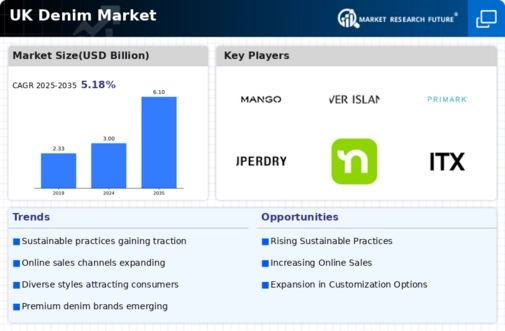The UK denim market exhibits a dynamic competitive landscape characterized by a blend of established brands and emerging players. Key growth drivers include a rising consumer preference for sustainable fashion, digital transformation, and the increasing demand for personalized products. Major companies such as Levi Strauss & Co (US), H&M (SE), and VF Corporation (US) are strategically positioned to leverage these trends. Levi Strauss & Co (US) focuses on innovation in sustainable materials, while H&M (SE) emphasizes its commitment to circular fashion. VF Corporation (US) is enhancing its digital capabilities to improve customer engagement, collectively shaping a competitive environment that prioritizes sustainability and technological advancement.
In terms of business tactics, companies are increasingly localizing manufacturing to reduce lead times and enhance supply chain resilience. The market structure appears moderately fragmented, with several key players exerting influence through strategic partnerships and collaborations. This fragmentation allows for niche brands to thrive alongside larger corporations, fostering a diverse range of offerings that cater to varying consumer preferences.
In October 2025, Levi Strauss & Co (US) announced a partnership with a leading sustainable fabric manufacturer to develop a new line of eco-friendly denim. This strategic move underscores the company's commitment to sustainability and positions it favorably in a market increasingly driven by environmentally conscious consumers. By integrating sustainable practices into its product development, Levi Strauss & Co (US) aims to enhance brand loyalty and attract a broader customer base.
In September 2025, H&M (SE) launched a digital platform aimed at enhancing customer experience through personalized shopping recommendations. This initiative reflects the company's focus on digital transformation and its efforts to engage consumers in a more meaningful way. By leveraging data analytics, H&M (SE) seeks to tailor its offerings to individual preferences, potentially increasing conversion rates and customer satisfaction.
In August 2025, VF Corporation (US) expanded its e-commerce capabilities by acquiring a technology startup specializing in AI-driven supply chain solutions. This acquisition is likely to enhance VF Corporation's operational efficiency and responsiveness to market demands. By integrating advanced technologies into its supply chain, the company aims to streamline operations and improve inventory management, which could lead to cost savings and increased profitability.
As of November 2025, current competitive trends in the UK denim market are heavily influenced by digitalization, sustainability, and the integration of AI technologies. Strategic alliances are becoming increasingly important, as companies collaborate to enhance their product offerings and operational efficiencies. Looking ahead, competitive differentiation is expected to evolve, shifting from price-based competition to a focus on innovation, technology, and supply chain reliability. This transition may redefine market dynamics, compelling brands to invest in sustainable practices and advanced technologies to maintain a competitive edge.






















Leave a Comment